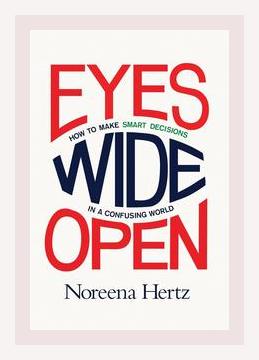Marketing and SalesBrand Management
Introduction
Noreena Hertz’s “Eyes Wide Open: How to Make Smart Decisions in a Confusing World,” published in 2014, addresses the complexities of modern decision-making. Hertz, an economist and author, dissects various forces that shape our choices and offers practical tools for better decision-making. Below is a detailed summary structured around the core themes and actionable advice provided in the book.
1. Information Overload
Major Point:
The modern world bombards us with information, often making it challenging to differentiate between what is useful and what is not. Hertz calls this phenomena “information overload.”
Example:
Hertz mentions how people are constantly inundated with emails, news updates, and social media notifications, making it difficult to focus and think critically.
Action:
To combat information overload, Hertz suggests implementing a “digital Sabbath” — a regular time period each week where you disconnect from digital devices. This allows you to reset and process information more effectively.
2. The Influence of Experts
Major Point:
We often rely on experts for guidance in various fields. However, experts can be wrong, biased, or influenced by external factors.
Example:
Hertz cites the 2008 financial crisis, where economists and financial experts failed to foresee the impending collapse, leading to global economic turmoil.
Action:
Develop a habit of questioning and cross-referencing expert opinions. For instance, seek out diverse perspectives and don’t rely on one single source of expertise.
3. Understanding Biases
Major Point:
Cognitive biases can cloud our judgment, leading to flawed decision-making.
Example:
The “confirmation bias,” where we favor information that confirms our existing beliefs and ignore contradictory evidence, can be particularly harmful.
Action:
Actively seek out information that challenges your viewpoint. Create a “devil’s advocate” scenario during decision-making sessions to ensure multiple perspectives are considered.
4. The Role of Emotions
Major Point:
Emotions heavily influence our decisions, often in ways we don’t realize.
Example:
Hertz discusses how fear can drive irrational financial decisions, such as panic selling during stock market drops.
Action:
Practice emotional regulation techniques such as mindfulness and meditation. These practices can help you identify and manage emotional triggers that might cloud your judgment.
5. Groupthink
Major Point:
Groupthink can lead to poor decisions as people conform to group norms and suppress dissenting opinions.
Example:
Hertz points to historical events such as the Bay of Pigs invasion, where groupthink led to disastrous outcomes.
Action:
Encourage a culture of open dialogue and constructive criticism within groups. Assign roles such as “critical evaluator” to some team members to ensure diverse viewpoints are heard.
6. The Power of Algorithms
Major Point:
While algorithms can aid in decision-making, over-reliance on them can be dangerous.
Example:
Hertz discusses the use of algorithmic trading in financial markets, which can lead to significant issues such as the Flash Crash of 2010.
Action:
Use algorithms as tools rather than crutches. Always combine algorithmic input with human intuition and oversight to balance decision-making.
7. Making Time for Reflection
Major Point:
Modern society often values speed over thoughtful reflection, which can lead to hasty and ill-considered decisions.
Example:
Hertz gives examples of CEOs who take short but regular retreats to focus solely on strategic thinking without the rush of day-to-day operations.
Action:
Schedule regular time blocks for deep, uninterrupted thinking. This could be daily, weekly, or monthly depending on your needs and schedule.
8. The Importance of Diverse Teams
Major Point:
Diversity in teams enhances decision-making by bringing in varied perspectives and reducing the risk of groupthink.
Example:
Hertz cites studies showing that diverse teams outperform homogenous ones in solving complex problems.
Action:
Intentionally build diverse teams by including people of different backgrounds, disciplines, and viewpoints. Foster an inclusive environment where all voices are valued.
9. Effective Communication
Major Point:
Clear and effective communication is essential for good decision-making.
Example:
Hertz notes how miscommunication has led to failures in both corporate and healthcare settings, with severe consequences.
Action:
Focus on developing strong communication skills. This includes active listening, being clear and concise, and ensuring that there is a mutual understanding among all parties involved in a decision.
10. Decision-Making Under Uncertainty
Major Point:
Uncertainty is an inevitable aspect of decision-making. Learning how to navigate and mitigate uncertainty is crucial.
Example:
Hertz describes the approach taken by successful entrepreneurs who often make decisions with incomplete information but use agile methodologies to adapt rapidly as new information becomes available.
Action:
Adopt an agile decision-making process. Break decisions into smaller, manageable parts and remain flexible to adapt based on new information or changing circumstances.
Conclusion
“Eyes Wide Open” by Noreena Hertz provides a comprehensive look at the factors that influence decision-making in our complex world. Through an exploration of information overload, expert influence, cognitive biases, emotional impacts, groupthink, algorithms, reflection, team diversity, communication, and uncertainty, the book equips readers with actionable strategies for making more informed and effective decisions.
Each major point in the book is paired with specific actions that individuals can take to enhance their decision-making processes. By implementing these strategies, readers can develop a more intentional and discerning approach to navigating the constant flow of information and pressures that define the modern decision-making landscape.
